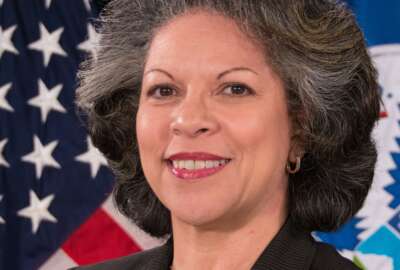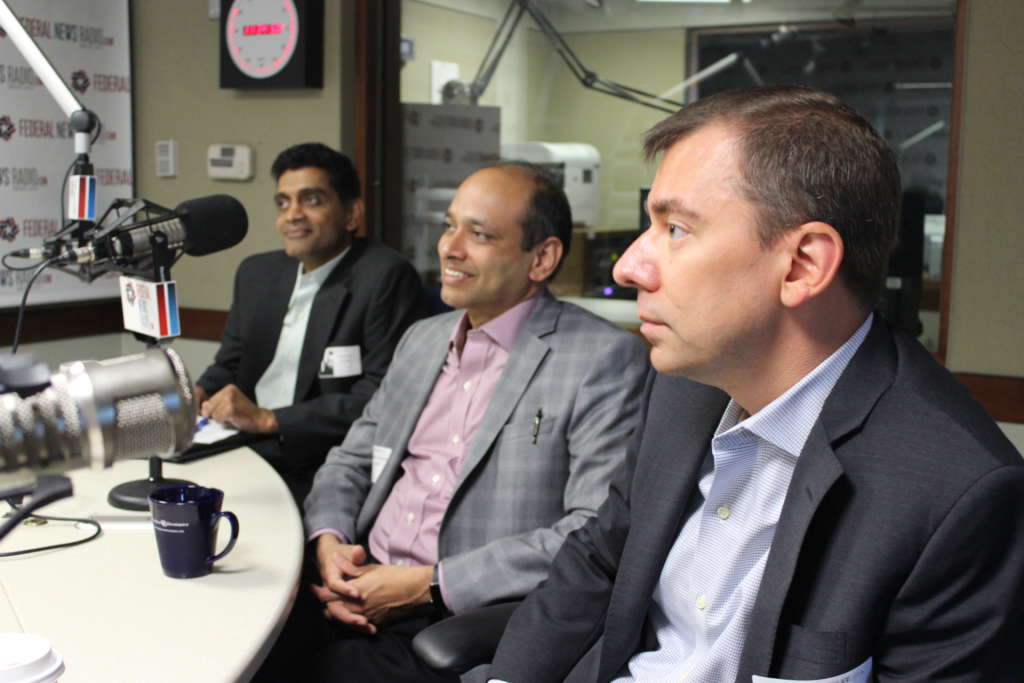

The executives from KarSun Solutions discussed why the IT modernization effort is helping bring innovation to the federal procurement market.
Views from the Corner Office is a new show designed to talk to the private sector leaders that influence and impact the federal market. The goal of this monthly discussion is for federal executives, lawmakers and other industry experts to gain insights and a better understanding into the trends, the challenges and the evaluation of the technology, acquisition and leadership in the federal market by the executives who lead the federal practices of government contractors.
Sundar Vaidyanathan CEO and co-founder, Kartik Mecheri, co-founder and chief architect and Terry Miller, the chief operating officer Karsun Solutions sat down with Federal News Radio’s executive editor Jason Miller at the station’s studios in Washington, D.C.

Here are some excerpts from that discussion.
JM: Is it a good time to be a government contractor?
SV: We feel like this is one of the best time to be in the federal market. The primary reason being that we see a real impetus behind the IT transformation, IT modernization within the government. We see executive support and the agencies are taking this modernization activities very seriously and we feel fortunate to be playing in this marketplace as one of the IT modernization experts. If a look at the focus on the agency executives in the past administration, there are a lot of initiatives that have been pursued, but this time we see a real teeth in terms of priority and focus on getting the IT modernization done across the government.
JM: Why is this time different than previous attempts over the past 18 years?
SV: I think one of the things that I absolutely was the IT modernization became the number one priority in the President’s Management Agenda, so that brought a lot of focus and they are really interested in trying new things out. Based on our observation that’s happening within the agencies, there seems to be a credible path and drive to get things done and they are willing to take new paths. I see that preference to engage with the disruptors of the government and we believe we are one of the disruptors in terms of bringing innovation to the federal government and we feel that it’s being heard more emphatically.
JM: When you talk about disruptors, what do you mean?
KM: The disruption happens in multiple angles. So what we are noticing is how you’re procuring services. We are seeing consistently that there is some new ways and new methods of procuring services that’s going on. It doesn’t matter whether you’re large or small, they are looking at different ways of procuring, which really levels the playing field for the doers as opposed to the talkers. So that’s one angle from the RFP procuring services perspective. The cloud is almost becoming mainstream. Pretty much all agencies are moving to commercial cloud. The other areas that folks are looking at includes artificial intelligence. How do I bring in machine learning and artificial intelligence into the market? The third aspect is things like robotic process automation (RPA). How do I bringing efficiencies within my workplace through robotic process automation and so forth? So disruptions are happening.
JM: Is there innovation happening in federal procurement?
SV: We have seen a clear trend in terms of innovative procurement processes across the agencies. The one notable thing that I wanted to point out is the [DHS] FLASH procurement and I know that there were inherent challenges with the administrative and some of the bookkeeping aspects of the procurement, but overall the philosophy around identifying some new real disruptors, it was very bold. That trend toward migrating toward that kind of procurement is a good sign. There’s a multi-phased approach to procurement. They are in engaging in a short-selection based on a video, which is something new. And then, more importantly, a challenge-based procurement…show don’t tell. And that’s where we are able to make a deep impact. Those procurement practices, I think they’re going to gain more traction as we continue along.
TM: We’re really seeing as a big part of that is it is leveling the playing field. That’s been very different in the way that things have been done before. If we think about traditional procurements where we had 50, 100 page RFPs that we needed to respond to, and in many ways it comes down to who’s got a better story to write. But now what we’re really seeing that’s very different is ‘prove it to me, come in and do a demonstration to show me exactly, you know, what you, what your capabilities are.’
JM: What challenges do small businesses likes yours face as they become more successful, particularly around growing out of the small business size standards?
SV: We need to be very careful about what we are going to compete on. So the two things we look at are–Is it fully aligned with our competency? I know Lockheed Martin can do anything they building from planes to running big programs. But we are focused on building a differentiated capability on those projects. Number two is we are also picking opportunities where we can demonstrate it using the show don’t tell approach. When you pick that kind of opportunity, I believe that we have a decent shot to differentiate and then we’re going to take a try on those.
We do see a few agencies and components who really prefer that nimbleness and agility of a small player, but the capability of a large player and that’s where Karsun is able to nicely differentiate, especially having $200 million past performance and then being the number of magical it gives more confidence for the customers.
TM: We’ve all come out of these large systems integrators and I think that the difference that we see is we run an agile company. We talk about agile development, but the way we run the company is agile. We can get to decisions quickly and we sit down and we really talk it through. I think one of the great things about it is that when we’re sitting down, we’re not letting emotions get in the way. We’re not letting things get in the way about this person needs to be right or this person doesn’t. We’re really looking at it saying, ‘what is the best decision? How do we get there quickly?’ Being able to do that is hard within a large company.
JM: Tell me something about yourselves outside of work and federal contracting.
KM: I was full time into making it big on cricket back in India. This was in my previous life. It almost feels like a dream now. I made it to a good level. Played combined universities, played for under-15 India, and was in the limelight. All of a sudden I said, ‘you know what, I’m going to focus on academia a little bit now.’ I shifted my thoughts around becoming an engineer and then coming to do my masters here [in America] and then got into a job here. But the big thing that as I retrospect about what I learned out of cricket and know there’s a huge amount, so what are I take forward from a team perspective and defeat and how do I gracefully accept it and move forward? It is really, really helping me from a team sport perspective.
TM: For me it’s very much about mind and body and keeping those things sharp. So I’m not up at four but I’m about five every day and make sure that I run at least three miles when I got up. At night I have my kind of regiment more about mind. I need to make sure that each night I play at least two games of chess. So that’s one of the things that I do and then one of the other things that I do is I read about theoretical physics. I love physics, so I’m always reading about it and looking at those types of things. So to me that’s kind of my daily regimen.
SV: I spend a lot of time with the kids and I coached them for their STEM competitions like Science Olympiad and science fair. I did something with their cognitive vision technologies like including drones and computer vision. That’s one other project that they sponsored for the kids. I have a son who is in high school right now.
Copyright © 2025 Federal News Network. All rights reserved. This website is not intended for users located within the European Economic Area.
Jason Miller is executive editor of Federal News Network and directs news coverage on the people, policy and programs of the federal government.
Follow @jmillerWFED


